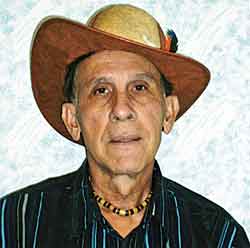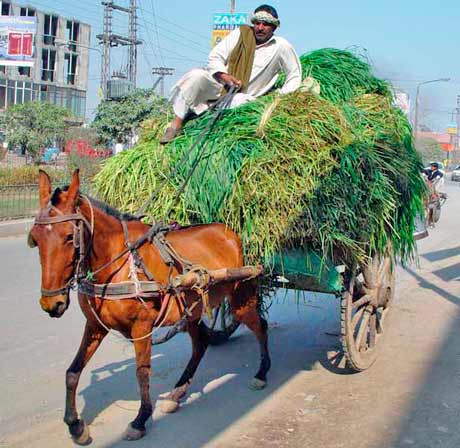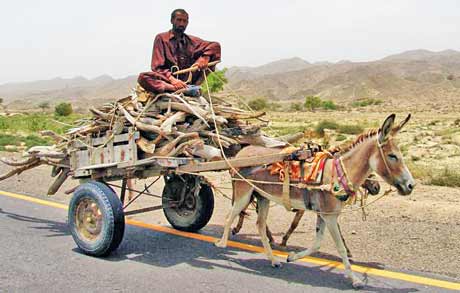December 7, 2011 issue
Arts & Entertainment
Coconut water from donkey-drawn
cart tasted best!

Bernard Heydorn
History is filled with stories of beasts of burden – horse, donkey, mule and ox. From Biblical times to modern, these animals have provided service to humanity. Lowly and loyal servants, they often receive little if any gratitude for the work they do.
When I was a child, growing up in Guyana, to call somebody "a jackass" (donkey) was one of the biggest insults. The term was used very often and in a derogatory manner – "That person is a jackass!" sometimes abbreviated simply to "a jack" (stupid, ignorant, a clown,

Donkeys and folks who used them were considered to be in the lowest strata of society. You would never see the Governor in a donkey cart. The Governor would never know the joy of riding a donkey bareback on a backdam road on a moonlight night.
There was "jackass rope" – homegrown tobacco twisted into a rope. In Barbados, there were stories of "the steel donkey" – a "jumbie"-like (ghost) animal with a big muffler hanging out, that scared the life out of females at night in some parts of the island. The jackass was also an improvised hammock made of rice bags that poor folks who could not afford better, used to lie and sleep in. Modern dancing at that time was called "a jackass parade". I guess I have participated in many "jackass parades" in my time.
In the Caribbean, when automobiles and vehicular traffic started to clog the roads, donkey or horse drawn carts were unceremoniously banned from the roads. They were considered a hazard that slowed users of the road. Before it came to that, automobile drivers used to honk their horns on the poor donkey cart and driver. The donkey cart driver would retaliate with some finger pointing and choice "cuss" words. It did not help matters when the "jackass" drivers fell asleep at the reins and the donkeys had to "read" the traffic lights and find their way home, which some miraculously did! In any case, donkey carts are now considered relics of the past.

At the appointed time the driver and the dray cart arrived. The cart had wooden wheels with iron hoops which made a clatter as it went down the road. This did not help matters if you wanted to move without being heard or seen. The two jackasses were tied loosely to eat what little grass there was on the ground. A grimy, mosquito and mud splattered kerosene lantern hung on the underside of the dray-cart. It gave out a pale light.
The donkeys swished their tails around to drive off the mosquitoes and insects of the night while the furniture was being loaded. Painted on the side of the cart was the owner's name, barely discernible. When it was all over, the driver climbed aboard, gathered the reins and bamboo stick (whip) and set off. A crack in a curtain next door closed – at least one neighbour had seen it all. In the distance, the driver was taking a few swigs from a "flattie" rum bottle which he hid under some rice bags in his cart.
As a child, I remember seeing the dog catcher in his boxed-in dray-cart, capturing and hauling away the unfortunate stray animals. He would lasso them and throw them into his cart where the animals would start fighting with each other. This was not a pleasant or high paying job!
Children who could afford it could get a ride on a donkey at a church fair. The ice-cream donkey cart selling fudgicles and popsicles was a welcome sight in the old days. The bread cart with bread, cakes and buns was also a daily sight in town and country. The knife sharpener in his donkey cart would be ringing his bell and making a clatter to announce his presence in the neighbourhood. He also sharpened cutlasses (machetes), scissors, and just about anything that had a blade.
Not to be outdone, the cloth peddler in his donkey or dray cart would have his cart full of haberdashery – cloth, needles, threads, lace, ribbons, zippers, trimmings and mor. A number of Portuguese and other immigrants to Guyana plied this trade in the 19th century. Some of these folks went on to own large and small stores in town and country.
The milkman in his cart with large milk cans from which he dipped measures of milk was a daily sight. Sometimes the milk would have been watered down and it was my father's job to test the milk and report it to the authorities. Charges and prosecution could follow.
The "rice man" also sold his rice from a cart. An East Indian rice cart vendor in New Amsterdam (who was also a money lender) was very generous with his rice measure. He always let the customer get the extra rice that came out with each dip from the rounded overflowing top. Later it came to light that he had a false bottom in his measure!
The rubbish (garbage) collector had a horse drawn cart. Animal drawn carts were also parked on the wharves and stellings to collect and transport produce for shops and stores.
One of my favourite carts was that of the coconut vendor. His green and yellow (Chinee) coconuts were stacked in bunches in his cart. With deft hand movements, he/she (coconut woman) cleared the top of the coconut to make a hole for the water and sweet jelly (soft or hard) within. You could always find a coconut vendor around the Savannah in Port-of-Spain in Trinidad and outside most markets. How the vendor did not lose a finger or worse is beyond me.
The shave ice (snow cone) man showed up in his cart blowing his whistle like he was a referee in a football game. The ice was carried in a large block which he got from the Ice House and which he covered with a crocus bag surrounded with saw-dust. He used a metal ice shaver to shave and compress the ice. On the top he poured a sweet red syrup which dripped all over your clothes as it melted and made your fingers "sticky fuh miles". His cart often left a trail of melted water along the road.
He and his donkey or push cart could be found at sporting venues, cinemas, outside of schools, the law courts or anywhere "the common man" congregated. On a visit to New York City a few years ago, I saw a shave ice man plying his trade in the streets. In the present recessionary climate, who knows, this trade might be making a comeback.
Horse drawn carts have been used as taxis and for special events like weddings or for tourists to visit neighbourhoods in cities. In days of old, the mule (a cross between a horse and a donkey) worked on farms in very poor conditions. The mule can be stubborn – as stubborn as a mule, the saying goes. Animals have been used for generation on farms for all kinds of work and little pay.
Driving along highways in Norfolk and neighbouring counties these days, one can still see horse drawn buggies owned by Mennonites trotting along the road, day and night. I have an old buggy on my front lawn with a horse (wooden). Needless to say the upkeep is minimal. One young couple even stopped to ask us if they could get a wedding picture taken on the buggy. In the summer time I go and sit on the buggy to relax.
God must have a special place for beasts of burden. Many of these placid creatures have endured uncalled for blows and whippings in their lifetime. Many have worked till they dropped. Never has so much been given by so hard working an animal for so little. Many years ago I wrote an article asking that I be taken to my final resting place in a donkey cart. I hope my wish comes true. If the creeks don't rise and the sun still shines I'll be talking to you.